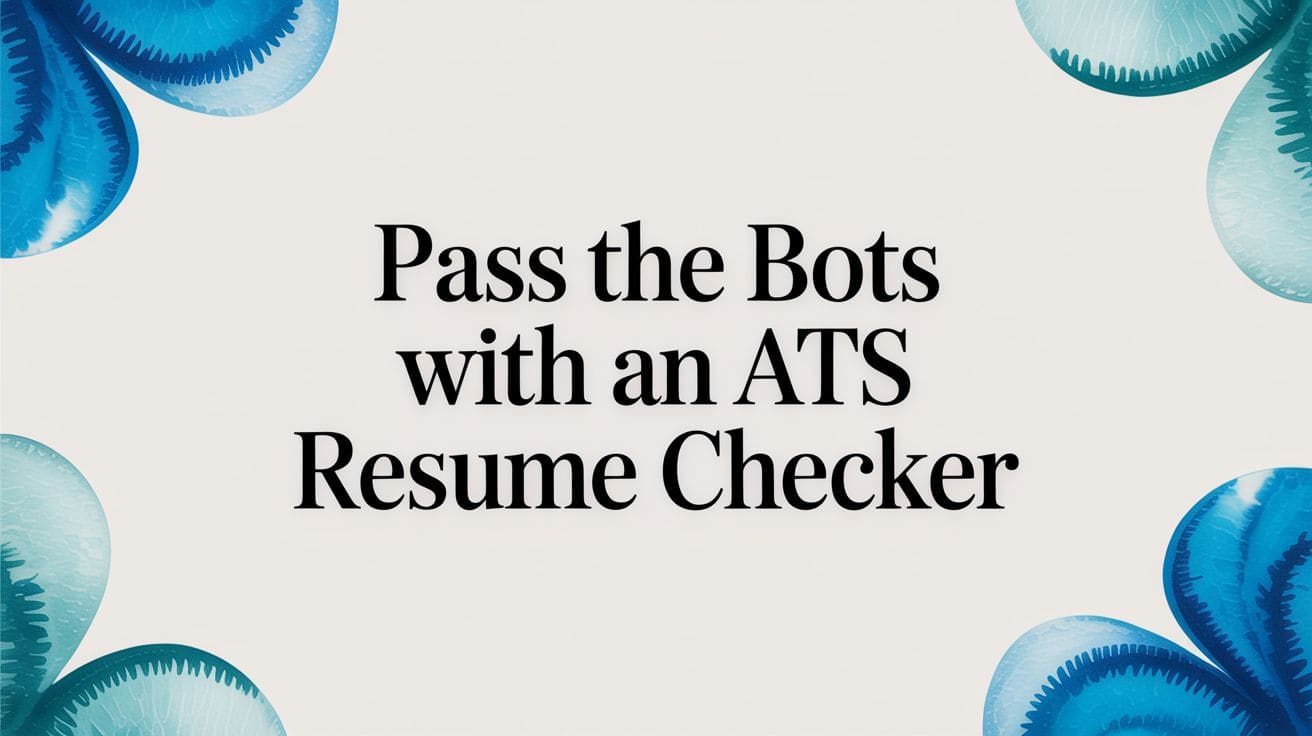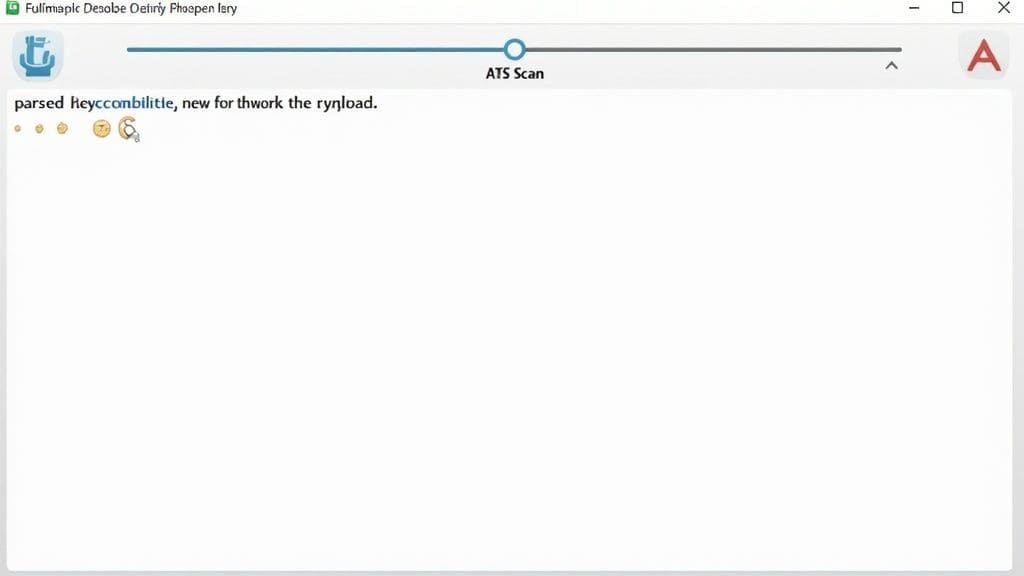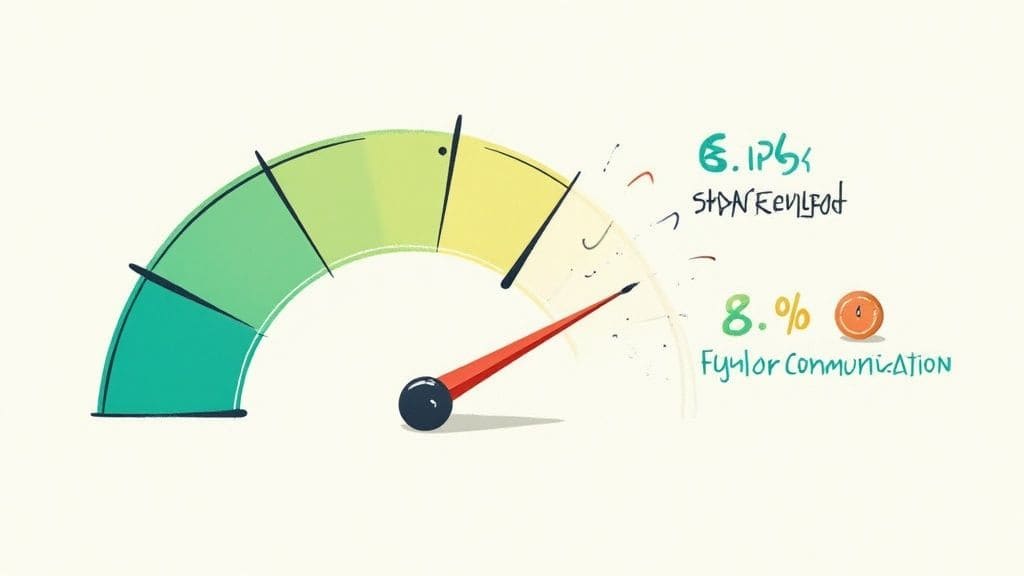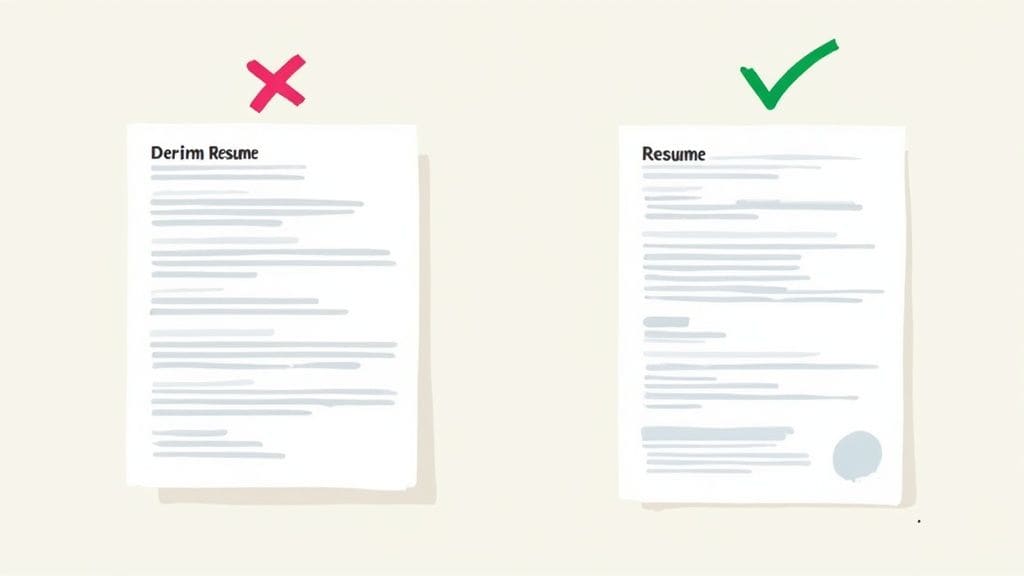Pass the Bots with an ATS Resume Checker
Tired of resume black holes? Learn to use an ATS resume checker to analyze your score, fix hidden errors, and finally get seen by recruiters.

Pass the Bots with an ATS Resume Checker
If you're applying for jobs online, your resume is almost certainly being judged by a robot first. Using an ATS resume checker is the best way to diagnose and fix the exact problems that get your application automatically tossed in the 'no' pile. These systems aren't scanning for nuance or potential; they're rigid, data-driven gatekeepers looking for specific keywords, conventional formatting, and a logical structure. By optimising your resume to pass this first test, you significantly increase your chances of it reaching a human hiring manager.
Why Your Resume Vanishes Before a Human Sees It

The initial gatekeeper for the vast majority of online applications today is the Applicant Tracking System (ATS). It's the primary reason so many qualified candidates get overlooked before a hiring manager even knows they exist. This software is now standard practice for companies drowning in the high volume of applications they receive for every single open role.
The reality is stark: 98% of major companies across the globe use ATS platforms to filter their applicants. The result? A staggering 75% of resumes get rejected at this automated stage, never making it to a human reviewer.
That's a tough pill to swallow, but it also gives you a clear path forward.
How an ATS Actually "Reads" Your Resume
An ATS isn't designed to find the "best" candidate in the way a person would. Its only job is to efficiently screen out applications that don't meet a list of predefined criteria. It does this by breaking your resume down into raw data.
Here's what it's looking for:
- Keyword Matching: The system scans for specific keywords and phrases pulled directly from the job description. If the posting asks for "SEO strategy" and "Google Analytics," the ATS is looking for those exact terms.
- Formatting Analysis: It expects to find standard section headings like "Work Experience" and "Education" in a clean, predictable layout. Funky columns, tables, or graphics can confuse it.
- Data Extraction: The ATS pulls key data points—your contact info, job titles, companies, and employment dates—to populate a candidate profile on the backend.
This is precisely where an ATS resume checker gives you a massive advantage. It simulates this parsing process, showing you exactly how your resume looks to the software and flagging the specific gaps or formatting errors that are causing it to fail.
An ATS doesn't understand your potential or ambition; it only understands data. Your job is to format that data in a language the system can read and interpret correctly.
To give you a clearer picture, here's a quick rundown of the most common reasons an ATS will filter out a resume before it ever reaches a human reviewer.
Common ATS Rejection Reasons
| Rejection Factor | Why It Happens | How an ATS Checker Helps |
|---|---|---|
| Keyword Mismatch | The resume lacks specific terms from the job description. | It identifies missing keywords and suggests where to add them. |
| Complex Formatting | The ATS parser can't read columns, tables, or text boxes. | It flags formatting that can cause parsing errors. |
| Unconventional Headings | Section titles like "My Journey" confuse the parser. | It ensures you're using standard headings like "Work Experience." |
| Graphics & Images | Logos, icons, or photos are unreadable to most systems. | It helps you focus on a clean, text-based document. |
| Incorrect File Type | Submitting a .pages or .jpg file instead of a .docx or PDF. | It reminds you to save and upload in a compatible format. |
Seeing these issues laid out makes it obvious: these are simple, fixable mistakes. A good checker spots them in seconds, so you can make quick edits and drastically improve your odds.
Beyond the Resume
Optimising your resume is the critical first step, but it's not the only one. A strong, consistent professional presence across multiple platforms can seriously boost your visibility. To maximise your chances in today's market, it's just as important to build a LinkedIn profile that stands out.
This creates a cohesive narrative for recruiters who will almost certainly look you up after your resume makes it through the initial screen. And don't assume only giant corporations are using these tools; even small companies are adopting them, a trend you can learn more about in this ultimate guide to applicant tracking systems.
Get your free CV review
Upload your CV and get instant AI suggestions to improve your chances
How to Run Your First Resume Scan

Alright, let's get down to business. Running a scan is simpler than it sounds, and it's the single best way to see your resume the same way a recruiter's software does. We're not talking about theory here; this is about taking direct action with an ATS resume checker to uncover the formatting flaws and keyword gaps that lead to an instant rejection.
Think of this as a quick diagnostic test for your career documents. An effective checker mimics how a real ATS parses text, flags weird formatting, and tries to match keywords. Your goal on this first run is simple: get a baseline score and a clear report that shows you exactly what needs fixing.
Getting Your Documents Ready
Before you hit that scan button, you'll need two things handy. A little prep work now makes the whole process smoother and ensures the results you get are actually useful.
- Your Resume File: Grab the latest version of your resume. Make sure it's saved as a .docx or PDF file, as these are the standard formats that play nicest with parsing software. Steer clear of odd file types like .pages or, even worse, image files like JPGs.
- The Target Job Description: Find the job posting you're applying for and have it open. You're going to need to copy and paste the entire text of the description into the checker.
This two-part system is what makes the analysis so powerful. It isn't just checking your resume against some generic list of best practices; it's measuring how well your resume is tailored to the specific role you're trying to land.
Uploading and Analysing
With your files ready, the scan itself takes just a few moments. Most checkers have a really straightforward interface with two main fields.
First, upload your resume file or paste its text directly into the designated box. Next, head over to the job description and copy everything—from the job title all the way down to the "About the Company" section. Don't skip the company bio; it often contains great keywords about culture and values. Paste that into the second box.
Now, just hit the "scan" or "analyse" button. The checker gets to work instantly, comparing both documents to see how well they line up.
The first scan is your roadmap. It's not about getting a perfect score on the first try; it's about revealing the specific, actionable steps needed to align your resume with the employer's requirements.
The results page will give you an initial match score (usually a percentage) along with a full breakdown of where you stand. You'll see things like missing keywords, formatting warnings, and other practical suggestions. This report becomes your blueprint for making targeted, effective edits.
For those starting from scratch and wanting to build a resume with these principles baked in from the start, using an AI-powered resume builder can give you a huge head start. This initial scan is the most critical step you can take toward turning automated rejections into actual interview invitations.
Turning Your Score Into Real-World Resume Edits

Alright, your scan is done. You're staring at a match score and a list of "keyword gaps." Now what? Think of this report as your personal roadmap. It's not just a grade; it's a specific, step-by-step guide showing you exactly where your resume and the job description don't line up.
Here's the rule of thumb I tell everyone: any score below 70-75% is a huge red flag. It's a strong signal your resume is on the fast track to the digital trash bin, never to be seen by human eyes. Your job now is to close those gaps in a way that feels natural and authentic.
How to Tackle Keyword Gaps
Your report will probably throw a mix of hard and soft skills at you. Hard skills are things like "SQL" or "Agile methodology," whilst soft skills are terms like "stakeholder communication." My advice? Start with the hard skills. These are often the non-negotiables, the deal-breakers that get you past the first round of screening.
The biggest mistake people make is just cramming these keywords into a list at the bottom of their resume. Don't do that. The most effective way to add them is to weave them directly into the bullet points under your work experience. This gives them context and proves you've actually used these skills.
Let's say you're a Project Manager, and the checker flags "risk management" and "Jira" as missing.
- Your original bullet point might be: Led a team through a six-month product launch.
- Your new, optimised bullet point: Led a cross-functional team through a six-month product launch, performing weekly *risk management assessments and tracking all deliverables within Jira*.
See the difference? That small tweak does two things at once: it satisfies the ATS bot looking for keywords and gives the human recruiter a much clearer picture of how you work. The goal is always to demonstrate your skills, not just list them.
Your match score is a direct reflection of your resume's relevance to a specific role. Boosting that score isn't about gaming the system; it's about making your relevance impossible for both software and humans to ignore.
Fixing the Other Stuff the Report Finds
A good ATS resume checker looks beyond just keywords. It'll often give you feedback on the nuts and bolts of your resume's structure—and you need to listen. These details can make or break whether the system can even read your information correctly.
Pay close attention to these common culprits:
- Section Headings: The ATS is looking for standard titles. Use "Work Experience," not something creative like "My Professional Journey." The robots don't appreciate creativity here.
- Date Formatting: Consistency is key. Stick to a simple format like MM/YYYY for every job and degree to prevent parsing errors.
- File Type: Unless the application says otherwise, your safest bet is always .docx or PDF. Other formats can cause major issues.
These might seem like tiny details, but they can have a massive impact on how accurately an ATS parses your resume. If you want to go deeper on this, our complete guide to a professional resume layout is a great resource.
With U.S. businesses getting around 180 applications per hire—a staggering 182% increase since 2021—companies rely on these AI screeners to manage the flood of resumes. Making these simple, strategic edits after running a check is how you turn a low score into a high chance of getting that interview.
Fixing Formatting That Confuses the Bots

You can pack your resume with all the right keywords, but if the ATS can't read it, you're invisible. Poor formatting is the silent killer of countless job applications, and it's one of the most common—and frustrating—reasons you're not getting calls back. A good checker is brilliant at spotting these structural flaws, showing you exactly what the machine sees... or more importantly, what it doesn't.
That slick template you found online? The one with the cool columns, custom fonts, and a stylish header? It might look amazing to you, but to an ATS, it's often a jumbled mess of unreadable text. The software isn't built for creative flair; it's built for simplicity and predictable patterns.
Standardising Your Section Titles
Let's start with an easy win: use conventional section headings. The ATS parser is programmed to look for standard terms like "Work Experience" to categorise your information. If it can't find them, it might just skip over entire chunks of your career history.
- Avoid This: "My Professional Story" or "Where I've Made an Impact"
- Do This Instead: "Work Experience" or "Professional Experience"
This rule applies across the board. Stick to boring but effective titles like "Education," "Skills," and "Certifications." It's a strategic choice to make sure every part of your background is correctly identified and sorted.
Sticking to a Simple Structure
Complex layouts are the number one cause of parsing errors. An ATS reads a resume from top to bottom, left to right. Anything that disrupts that simple, linear flow—like columns or text boxes—can cause it to misinterpret or completely lose your data.
Simple, clean, and conventionally structured isn't just a safe choice—it's the most effective way to guarantee the machine can pass your information to a human reviewer accurately. The goal is readability for robots first, then humans.
To keep your resume clean and parsable, here's what you need to do:
- Use a single-column layout. Multi-column designs are a huge red flag. The ATS often reads straight across the page, mashing text from different columns into nonsense.
- Eliminate tables and text boxes. These elements are notorious for confusing parsers.
- Stick to universal fonts. Use common, easy-to-read fonts like Arial, Calibri, Georgia, or Verdana.
It's easy to see why this matters. The adoption of AI-driven resume screening is projected to hit 83% amongst companies worldwide by 2025, and 99% of Fortune 500 companies already use ATS platforms. Even more telling, 21% of companies now permit AI to reject candidates without any human oversight, which makes a technically flawless resume more critical than ever. You can dig into more of this data on how AI screening is shaping modern hiring.
To help you visualise the do's and don'ts, here's a quick comparison of what works versus what breaks the system.
ATS-Friendly Formatting vs. Common Mistakes
| Element | ATS-Friendly Approach | Common Mistake to Avoid |
|---|---|---|
| Layout | Single-column, linear flow from top to bottom. | Multi-column layouts, tables, or text boxes that confuse reading order. |
| Fonts | Standard, universal fonts like Arial, Calibri, or Verdana. | Custom, script, or overly stylised fonts that are hard to parse. |
| Section Titles | Standard headings like "Work Experience" and "Education." | Creative or unconventional titles like "My Journey" or "Achievements." |
| Graphics | No logos, photos, or complex charts. Simple bullet points are best. | Including a headshot, skill-level meters, or other visual elements. |
| File Type | Save as a .docx or a text-based PDF file. | Image-based PDFs, .jpg, or .png files that can't be text-scanned. |
Getting these basics right is non-negotiable for passing the first filter.
If you want to bypass these formatting headaches entirely, the smartest move is to start with a proven foundation. Using a professionally designed and tested ATS-friendly resume template ensures your structure is flawless from the get-go, letting you focus on what really matters: showcasing your skills and experience.
Iterate and Rescan for a Winning Score
Think of resume optimisation as a feedback loop, not a one-and-done task. You've put in the work, weaving in the right keywords and cleaning up your formatting. Now it's time to see the payoff.
Running your updated resume and the original job description through the ATS resume checker a second time gives you tangible proof of your efforts. Did your score jump from a shaky 65% to a much healthier 85%? That rescan is your confirmation that you've successfully plugged the gaps the checker found the first time around.
Aiming for the Green Zone
The whole point of this process is to get your resume into the "green zone." For most ATS tools, that magic number is a match score of 80% or higher. Hitting this benchmark is what dramatically increases your odds of getting flagged as a strong match and actually landing on a recruiter's desk.
A score in this range tells the software your skills and experience are tightly aligned with what the hiring manager is looking for. This final check is what gives you the confidence to finally hit that 'submit' button.
An 80%+ match score doesn't guarantee an interview, but a score below 70% almost guarantees your resume gets filtered out. This final scan is your last quality check before sending your application out into the world.
Confirming Your Edits Worked
When you get your new report, don't just glance at the score. Dig into the details to make sure the specific issues flagged in the first scan are gone.
- Keyword Gaps: Are the hard and soft skills that were missing before now showing up as included?
- Formatting Errors: Have the warnings about columns, funky fonts, or weird section titles disappeared?
- Content Analysis: Is the tool now correctly recognising your employment dates and job titles?
Seeing these specific fixes provides clear evidence that your changes hit the mark. This cycle of editing and rescanning is the core of a modern, effective job search strategy. If you're looking to build this optimisation process in from the very beginning, understanding how an AI resume builder can streamline your workflow is a total game-changer.
Ultimately, this final scan isn't just about pleasing a machine. It's about crafting a powerful, targeted document that screams "I'm the right person for this job." Once your score is in the green and the major red flags are gone, you can apply knowing you've given yourself the best possible shot at getting noticed.
Answering Your Questions About ATS Resume Checkers
It's completely normal to have a few questions when you first start using an ATS resume checker. Getting a handle on how these tools work—and how they don't—is the key to using them strategically instead of just chasing a high score.
Let's clear up some of the most common concerns around accuracy, what a "good" score really is, and how to deal with tricky career situations.
How Accurate Are These Checkers, Really?
This is the big one. A good checker does an excellent job of mimicking how the vast majority of Applicant Tracking Systems actually parse a resume. Whilst it's true there are hundreds of different ATS platforms out there, they all tend to fail for the same reasons: keyword gaps, funky formatting, and weird structural choices.
Think of an ATS checker as a universal pre-flight check. It's designed to spot the common problems that get resumes rejected across most systems, giving you a chance to fix them before you hit "apply."
What Is a Good ATS Match Score?
So many people make the mistake of chasing a perfect 100% match score. This almost always leads to a clunky, keyword-stuffed resume that will make a human recruiter cringe. Don't do it.
Instead, your target should be the "green zone"—a score of 80% or higher.
Hitting that number tells the system you're a highly relevant candidate without making your resume unreadable for a person. That last 20% often comes down to super-niche keywords or awkward phrasing that won't make or break your chances. The goal is simple: get past the bot, then wow the human.
Do I Really Need to Tailor My Resume for Every Single Application?
Short answer: Yes. Absolutely. This is non-negotiable if you want to be competitive.
Every company uses slightly different language in their job descriptions and values a different mix of skills. Using a checker for each application helps you spot those nuances and make small, critical tweaks that perfectly align your experience with that specific role.
Trust me on this: sending ten highly tailored resumes is way more effective than blasting out 100 generic ones. A targeted approach is how you get noticed.
How Should I Handle Missing Skills or Bias Concerns?
Honesty is always the best policy. Never, ever add a skill or qualification to your resume that you don't actually have.
If the checker flags a required skill you're missing, that's useful feedback. Maybe that role isn't the right fit. If it's a "preferred" skill, you can often still be a strong candidate without it.
And if you see a core requirement popping up again and again in jobs you want, that's a signal. It might be time for some professional development, like an online course or a new certification, to make you more competitive for the next role you go after.
The conversation around hiring bias is a significant one, and it's worth exploring how advancements are focused on reducing hiring bias with AI tools to create a more equitable process for everyone.
At the end of the day, an ATS resume checker is a diagnostic tool. It's not the final judge. It gives you the data to make smart decisions, ensuring your resume speaks the language the system understands and clears the path for you to make your case to a human.
This proactive approach is how you stop just applying for jobs and start truly competing for them.
Stop letting your resume get lost in the digital void. CV Anywhere's JD Fit Checker gives you an instant analysis and actionable steps to beat the bots and land more interviews. Build your winning resume today at CV Anywhere.
Tags
Related Articles
8 Critical ATS CV Mistakes to Avoid in 2025
Applicant Tracking Systems (ATS) are the gatekeepers of modern recruitment. To ensure your application makes it to a human, you must avoid the most common ats cv mistakes that cause these systems to m...
Read more →How to Write a Professional CV That Gets Results
A professional CV is a comprehensive dive into your career history, skills, and qualifications, designed to give potential employers the full picture of your expertise. Unlike a shorter resume, it det...
Read more →How to Write a Software Engineer Resume That Lands Interviews
How to Write a Software Engineer Resume That Lands Interviews To land a top software engineering role, your first challenge isn't impressing a human—it's satisfying a piece of software called an Appli...
Read more →Popular Articles
Finding the right cv template google docs can be a great starting point for your job search, but it's often not the most effective path to getting hired. Whilst templates offer a visual framework, the...
The best way to craft a comprehensive and professional CV of curriculum vitae is with a dedicated tool like CV Anywhere's CV builder. It ensures your document is perfectly formatted and optimised to h...
Stop searching for the perfect template of resume. Trawling through hundreds of options to find one that fits your experience is an outdated, frustrating process. The solution isn't a better template;...
Here is a detailed breakdown of the 12 best options for a resume maker for free available today. We've done the research for you, so you can stop searching and start building a professional, job-winni...
Picking the right resume templates is your first—and most important—move in getting a recruiter's attention. It's not just about looks; a great template is a strategic tool. It organizes your career s...